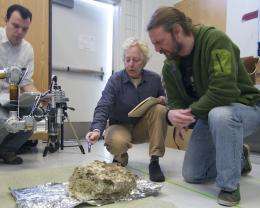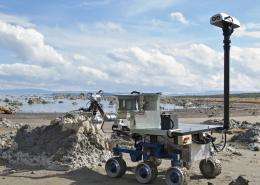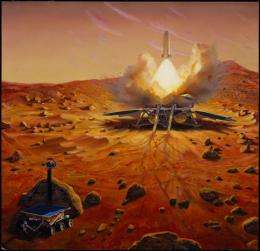Bringing a bit of Mars back home

If there is evidence of life on Mars, it will be found in the planet’s rocks. And as most scientists who study Mars will tell you, the best way to learn about martian rocks is to bring a few back to Earth.
NASA has long had plans for a sample-return mission to Mars. In the 1990s such a mission was on the agency’s active to-do list, with sample return planned to occur as early as 2008. But the failure of two successive Mars missions, Mars Climate Orbiter and Mars Polar Lander, led NASA to rethink its entire Mars-exploration strategy, scrapping sample return as a near-term goal.
Now, however, talk of sample return is once again in the mix. While no project has yet been funded, ideas about how it might be accomplished are under serious discussion. One such idea calls for the launch in 2018 of a rover, tentatively dubbed MAX-C (Mars Astrobiology Explorer-Cacher), tasked with collecting some twenty rock and dust samples. MAX-C would store these samples in a sealed container, which years later would be retrieved by a second rover and launched into orbit around Mars. A third spacecraft would then capture the orbiting cache and return it to Earth.
Although MAX-C is still only a proposal, work has begun to build and test prototypes of drilling and caching systems that could make it a reality. Last month, a group of scientists and engineers traveled to Mono Lake, California, in the company of a six-wheeled rover named Pluto, to field test one of these systems.
Taking part in the field test were several engineers, members of the robotics team that developed the coring and caching system at NASA’s Jet Propulsion Lab (JPL), and scientists from AMASE (Arctic Mars Analog Svalbard Expedition), a NASA-funded group that for the past several years has explored Mars-analog sites on the Arctic island of Svalbard. Part of AMASE’s charter is to test instruments for Mars-rover missions; in past years they have tested instruments for NASA’s Mars Science Laboratory and the European Space Agency’s ExoMars rovers.

Mono Lake was chosen as a test site, explained AMASE co-investigator Pamela Conrad, who coordinated the field test, both because of the site’s accessibility, and because of the “variety of interesting evaporite minerals found there,” including some unusual calcium-carbonate formations. On Mars, ancient evaporite deposits, left behind billions of years ago by evaporating water, are widely thought to be among the best places to look for evidence of past martian life.
Mono Lake is also “pretty otherworldly, Conrad added. “When you are doing a field test, you’re not just doing an analog for a certain set of chemical characteristics or a certain set of physical characteristics, you’re also doing an analog for the strangeness of it all.” She stressed that in a field test, it’s good to get out of one’s comfort zone, to encounter the unexpected.
Onboard the rover were two interrelated instruments designed and developed at NASA’s Jet Propulsion Lab (JPL): an experimental caching subsystem, referred to as the “SHEC” (Sample Handling, Encapsulation and Containerization), and a newly designed drill, mounted on a multi-jointed robotic arm.
The SHEC was comprised of a carousel containing four hollow drill bits, as well as a squat round container -- roughly the size and shape of a 50-pack of blank CDs -- in which were stored 19 hollow metal cylindrical sleeves, each about the width and length of a stubby human index finger.
At the start of each coring operation, the SHEC inserted an empty cylinder into one of the bits, and the bit was attached to the drill. The rover then drove up to a target rock and positioned the bit at the desired location. As the bit chewed a ring-shaped hole into the rock, a sample of the rock was forced up into the cylinder, much the way an apple core is forced up into a kitchen coring tool as you press down on it.
The SHEC then capped and stored the filled cylinder and the bit was returned to its carousel, to be used again in a subsequent coring operation. Although the final version of the system will be automatic from end-to-end, during the Mono Lake field test some steps required human intervention.
Considering that, prior to the Mono Lake test, the drilling and caching system had been tested only in a warm, cozy lab at JPL, field operations went exceptionally smoothly.
“When we’re in the lab,” said Paulo Younse, the JPL mechanical engineer who built the SHEC, “it’s just nice room temperature the whole entire time. Everything works exactly the same.” But “we were running at 5 to 10 degrees Celsius (41 to 50 degrees Fahrenheit) outside in the morning…. We actually had to put hand warmers on the [rover’s] cameras to keep them warm.” One team member also had to strap a set of spare batteries around his waist to prevent them from getting too cold.
Although at times the group was forced by bad weather to work indoors, the test was successful because it provided an opportunity for interaction between the scientists and engineers.
“There has to be more of an interface between scientists and engineers to understand each other in the development process of a mission like Max-C,” said Andrew Steele, principal investigator for AMASE. “Scientists must concentrate on the important parts of what they want to achieve, their important hypotheses, and how they want to test them, at an early enough stage to feed it into [the engineers] during the development process.”
In particular, during hardware development, the engineers had no immediate need to focus on cleanliness. “When we’re testing hardware we just run all the motors, do all the operations. We don’t necessarily go through all the swabbing and test procedures,” Younse explained.
But part of the design of the field test was to more closely mimic what operations on Mars would be like. Because the goal of the proposed MAX-C rover will be to retrieve rock samples that will help determine whether or not there was ever life on Mars, it will be critically important that any parts of the sampling and caching system that come in contact with martian rock and soil be free of contaminants from Earth. So during field operations, a significant amount of time was spent cleaning even microscopic amounts of contaminants from drill bits and sample cylinders, and then verifying that they were, indeed, clean.

Despite the weather, operations exceeded the expectations of nearly everyone involved. Often in a preliminary field test, hardware breaks, software is glitchy, and the scientists spend a lot of time standing around waiting for the engineers to fix things. At Mono Lake, however, both hardware and software worked almost flawlessly.
Two problems that did crop up were the result of coring into rocks that differed substantially from those previously tested in the lab. One was that, unlike the test samples used in the lab which had smooth surfaces, the calcium carbonate rocks at Mono Lake had rough, irregular surfaces that made the drill bit jump around so violently the entire rover shimmied in response. Eventually, though, the bit chipped away enough material to create a smooth-surfaced depression that could guide the bit deeper into the rock.
A second surprise was the effect of moisture inside some of the rocks. When the rover drilled into these rocks, wet, pulverized material collected inside the cylinder, turning to a thick, sticky clay that caused the drill bit to jam.
Neither of these problems was insurmountable, however, and the lessons learned from them will contribute to refinements in the next iteration of the drill-system hardware. Both the drilling and caching systems are currently being revamped, and the revised hardware will hopefully be ready in time to test this summer when the AMASE team makes its annual trek to Svalbard.
Source: Astrobio.net



















